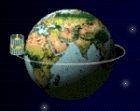|
Welcome to GG GG is a space project for a small satellite in low Earth orbit devoted to testing the Equivalence Principle (EP) of Galileo, Newton and Einstein to 1 part in 1017. This would improve the current best results by rotating torsion balances and Lunar Laser Ranging by 4 orders of magnitude. In GG the test masses are concentric hollow cylinders (10 kg each) in rapid rotation around their symmetry axes suspended and coupled by very weak mechanical suspensions; the corresponding natural oscillation frequencies are much smaller than the spin frequency, which case is referred to as "supercritical rotation". Weakly coupled test masses are very sensitive to differential forces such as the force due to a possible EP violation. If in addition the system is in rapid rotation, the differential signal is modulated at high frequency, which is well known to be beneficial for noise reduction. The GG experiment is run at room temperature; the spacecraft is spin-axis stabilized by a high angular momentum and no active attitude control is needed. In the current version, air drag and other non gravitational forces acting on the spacecraft surface are partially compensated by FEEP (Field Emission Electric Propulsion) ion thrusters needing only a few grams of propellant for the entire mission duration, hence perturbations from moving masses inside the spacecraft are negligible. If the test bodies fall differently in the field of the Earth because of EP violation there is a relative displacement vector of their centers of mass whose amplitude depends on the stiffness of the differential mechanical coupling; the displacement vector is pointed to the center of the Earth. Such mechanical displacement is transformed into an electric potential signal via a capacitance read-out system whose plates are located halfway between the test cylinders. Since the plates spin with the system the expected signal is modulated at the spin frequency (1 Hz in the current baseline). In the original torsion balance experiments performed by Eötvös the signal was DC and there was no frequency modulation. Subsequent experiments have allowed better results (finding no violation to the level of 10-13) based on modulation frequencies more than 3 orders of magnitude slower than in the GG proposed experiment. GG has been selected by the Italian Space Agency (ASI), within its Small Mission Program, for a Phase A Study in 1997 ( GG Phase A Report, ASI 1998; updated 2000). The best orbit for the experiment is almost equatorial (low altitude, small eccentricity). A full scale prototype of the GG payload (named GGG) has been built in order to demonstrate the main features of the space experiment. GGG is now operational in a dedicated INFN lab in Pisa. In November 2004, at completion of a general ASI funded national study on "Cosmology and Fundamental Physics in Space", GG has been given top priority as a small national scientific satellite. As a consequence, GG has become part of the National Aerospace Plan of ASI for the years 2006-2008. In this framework ASI has funded a Phase A-2 Study of GG carried out in 2009 by Thales Alenia Space, Italy (TAS-I) of which a synthesisreport is available online (Phase A-2 Study Report (as of April 2009); in addition, ASI has contributed to the INFN GGG laboratory experiment funding a new ad-hoc vacuum chamber and a new passively suspended prototype (under completion) designed to reduce low frequency terrain tilts hence getting closer to the target sensitivity to be achived by GG in space (see best GGG results reported at GG/GGG Workshop, February 2010) anna nobili |
|---|


